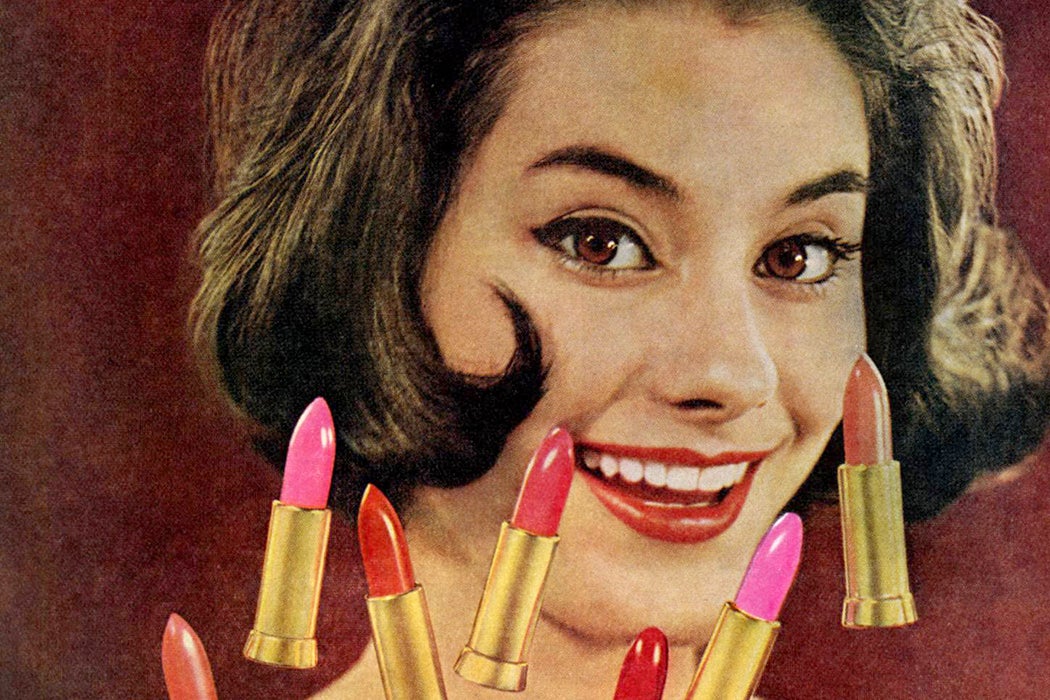After lower sales over the last few years because of pandemic masking, lipstick is this summer’s comeback kid. But lipstick usage has always been cyclical, explains legal scholar Sarah E. Schaffer. It’s a cycle that includes much more than beauty: gender, class, health, and religion have played a role in its popularity from the very beginning.
Lipstick hasn’t always been safe, though as Schaffer notes, “Historically, one was relatively less likely to die from lipstick than from most other cosmetics products.” The first known lipstick was created somewhere around 3500 BCE and was worn by Queen Schub-ad of ancient Ur. The lip tint contained a mix of “white lead and crushed red rocks” and became so popular that people would be buried with cockleshells full of it. In Egypt, all genders used makeup as part of a daily routine, the vibrant color coming from red ochre, “either applied alone or mixed with resin or gum for more lasting finish.” Other popular colors included orange, magenta, and blue-black, and as in Ur, those with the means were buried with at least two pots of lip color.
The vibe was decidedly different in ancient Greece. A backlash against “rampant reliance on lipstick’s artificial beauty” shifted its social status: in the Greek empire, lip paint was mainly worn by sex workers. Red was still in vogue, achieved by dyes and wine, as well as “extraordinary ingredients as sheep sweat, human saliva and crocodile excrement.” The status shift also led to the first regulations for the cosmetic, but not for the safety reasons you would think, given the ingredients. Because of lip paint’s “potential deception of men and the undermining of class divides,” its use led to new laws; prostitutes “could be punished for improperly posing as ladies” if they appeared in public without their lip paint and other makeup.
The rise of the Roman empire saw lipstick, once again, becoming chic. Men used it to indicate their social standing, and wealthy women used it for fashion. However, beauty and status came at a price. The ingredients—ochre, iron ore, and fucus plants—“infused lip paint with a potentially deadly poison.”
Lipstick usage declined during Western Europe’s Early Middle Ages (roughly 500–1000 CE) as there was a “gradual but distinct shift in favor of a rather plainer, and possibly slightly less washed existence.” By the High Middle Ages (1000–1300s CE), religion took lipstick off the must-have list. In England, Schaffer explains, women who wore make-up were understood to have entered into a pact with the devil, “because such alteration of her given face challenged God and his workmanship.”
Fast forward to the 1700s, when England imposed even harsher restrictions on make-up: Parliament passed legislation that made anything that altered a woman’s appearance—wigs, false teeth, and high heeled shoes, among them—grounds for having her marriage annulled or being tried for witchcraft. As Schaffer writes, this is another law that protected men, but it had a surprising outcome for women. Because of it, fewer women bought lipstick, which at the time often contained mercury-laden vermilion. The restriction likely saved many of women from poisoning.
Prohibition of lipstick also meant that it became a dirty little secret or a look women tried to achieve through clandestine means. In the Victorian era, thanks to the Queen’s public declaration that makeup was “impolite,” women resorted to lip biting, rubbing red ribbons on their lips, and trading recipes for lipstick “with their friends in underground lip rouge societies.” For women of privilege, trips to Paris, where they could buy Guerlain’s lip pomade of grapefruit, butter, and wax, were a sneaky but suitable solution.
Weekly Newsletter
In twentieth-century America, suffragettes used lipstick “as an emblem of women’s emancipation.” Color began showing up on the lips of more and more women. But safety was still an issue. As Schaffer describes, the “common American recipe of crushed insects, beeswax and olive oil produced lipstick with an unfortunate tendency to turn rancid several hours after application.” It wasn’t until 1938, when the United States passed the Food, Drug, and Cosmetics Act, that safety standards were introduced; no more could cosmetics include “poisonous” or “deleterious” substances. In the following decades, additional laws, particularly at the state level, would introduce even tighter safety regulations for cosmetics.
Lipstick is a surprisingly political product. From the early uses in ancient societies, to rebellious years of the 1970s when it was “adopted by both sexes of the punk-rock music and cultural movement to express sex, violence and general nonconformity,” to current debates over the use of animal testing to ensure consumer safety, it’s now a common if still sometimes controversial sight. But, as Schaffer cautions, lipstick’s pattern of going “from the heights of popularity to the depths of social unacceptability make[s] it much more likely than most people probably imagine for lipstick to go severely out of fashion.”
Editor’s Note: This article was updated to fix broken link tag.







